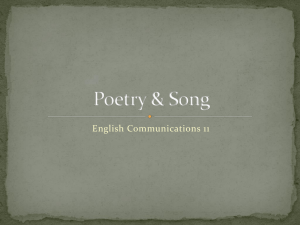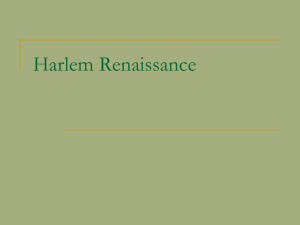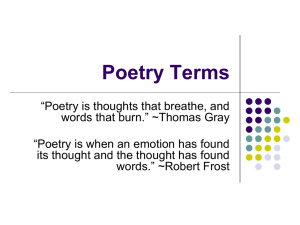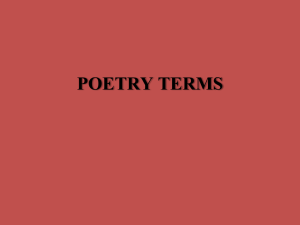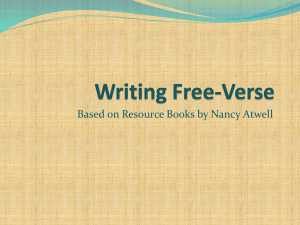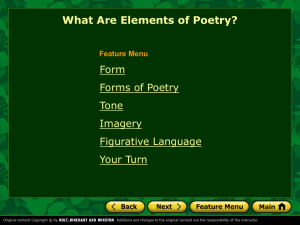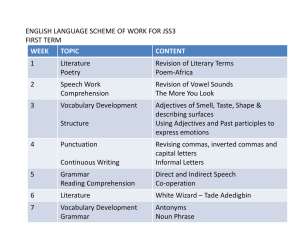Poetry Strand
advertisement
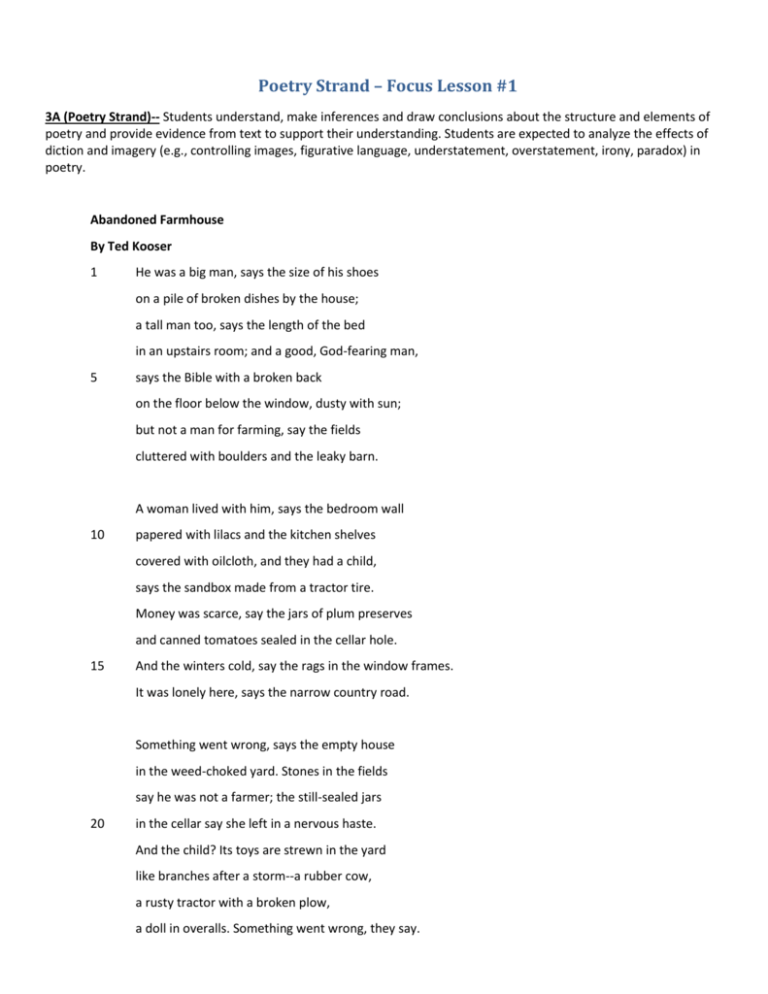
Poetry Strand – Focus Lesson #1 3A (Poetry Strand)-- Students understand, make inferences and draw conclusions about the structure and elements of poetry and provide evidence from text to support their understanding. Students are expected to analyze the effects of diction and imagery (e.g., controlling images, figurative language, understatement, overstatement, irony, paradox) in poetry. Abandoned Farmhouse By Ted Kooser 1 He was a big man, says the size of his shoes on a pile of broken dishes by the house; a tall man too, says the length of the bed in an upstairs room; and a good, God-fearing man, 5 says the Bible with a broken back on the floor below the window, dusty with sun; but not a man for farming, say the fields cluttered with boulders and the leaky barn. A woman lived with him, says the bedroom wall 10 papered with lilacs and the kitchen shelves covered with oilcloth, and they had a child, says the sandbox made from a tractor tire. Money was scarce, say the jars of plum preserves and canned tomatoes sealed in the cellar hole. 15 And the winters cold, say the rags in the window frames. It was lonely here, says the narrow country road. Something went wrong, says the empty house in the weed-choked yard. Stones in the fields say he was not a farmer; the still-sealed jars 20 in the cellar say she left in a nervous haste. And the child? Its toys are strewn in the yard like branches after a storm--a rubber cow, a rusty tractor with a broken plow, a doll in overalls. Something went wrong, they say. Poetry Strand – Focus Lesson #2 3A (Poetry Strand)-- Students understand, make inferences and draw conclusions about the structure and elements of poetry and provide evidence from text to support their understanding. Students are expected to analyze the effects of diction and imagery (e.g., controlling images, figurative language, understatement, overstatement, irony, paradox) in poetry. Women By Alice Walker 5 10 15 20 25 They were women then My mama’s generation Husky of voice—stout of Step With fists as well as Hands How they battered down Doors And ironed Starched white Shirts How they led Armies Headragged generals Across mined Fields Booby-trapped Ditches To discover books Desks A place for us How they knew what we Must know Without knowing a page Of it Themselves. Poetry Strand – Focus Lesson #3 The Oyster Author: Unknown 1 5 10 15 20 25 30 35 There once was an oyster Whose story I tell, Who found that some sand Had got into his shell. It was only a grain, But it gave him great pain. For oysters have feelings Although they’re so plain. Now, did he berate The harsh working of fate That had brought him To such a deplorable state? Did he curse at the government, Cry for election, And claim that the sea should Have given him protection? No – he said to himself As he lay on a shell, Since I cannot remove it, I shall try to improve it. Now the years have rolled around, As the years always do, And he came to his ultimate Destiny – stew. And the small grain of sand That had bothered him so Was a beautiful pearl All richly aglow. Now the tale has a moral; For isn’t it grand What an oyster can do With a morsel of sand? What couldn’t we do If we’d only begin With some of the things That get under our skin. “Abandoned Farmhouse” 3 By Ted Kooser 1 2 What does the figurative language in lines 4-6 emphasize? A The man mistreated his books. B The family did not keep the house clean, so the Bible is on the floor covered in dust. C The man read the Bible so much that he did not spend enough time working the farm. D The farmer abandoned his faith and his Bible when he left the farm. 4 What is symbolic about line 2? A The broken dishes are symbolic of the family’s broken dreams. B The poem is symbolic because it is told from the point of view of the dishes. C The man without shoes is symbolic of the family’s poverty. D The woman washed and broke the dishes outside. 5 Read lines 21-24 of the poem. The poet uses figurative language and details to show – A The child did not know how to put his toys away. B The child’s farm toys are purposely abandoned just as the farmhouse is. C How the toys are scattered in a random, violent way. D The parents do not know where the child is. What do lines 9-11 tell the reader about the character of the woman? A The woman resented living on the lonely country road. B The woman was nervous and always in a hurry. C The woman took pride in her home and worked to make it as nice as possible. D The woman wasted money on plum preserves and canned tomatoes. In the last stanza, which words best support that the idea that the family had given everything they had to make the farm a success, but nature worked against them. A nervous haste and branches B empty house and weed-choked yard C storm and rubber cow D rusty tractor and broken plow “Women” 3 By Alice Walker 1 A To emphasize the importance of women in the work force when men were at war. B To emphasize the figurative battle the African American women fought to gain rights for their children. C To emphasize the hardships women faced when walking in the country. D To emphasize the bravery of the Generals in the war. Read lines 2-6 of the poem. The poet uses imagery to show – A The both the women’s physical strength and strength of character. B The women were violent and hit things with their fists. C The women discovered books and desks for their children. D 2 What is the poet’s main purpose in lines 12-18? The women were overweight. What is ironic about lines 22-26? A Even though the women were uneducated they knew that their children needed education to be successful. B Even though the women never went to school, they already knew everything they needed to know. C Even though the women were grown, they felt it was their right to get an education for themselves. D 4 Even though the women were educated, it was unfair that they worked as laundresses and maids. 5 In line 7, the word battered means – A Batted in a baseball game. B Covered in a soft flour mixture. C Damaged with repeated blows. D Well armored ship. What do the words, ironed in line 9 and headragged in line 14 suggest? A The women felt their responsibility was to cook and clean for their own families. B The women wanted to leave their current jobs and join the army. C They needed to go to a hair salon. D The women worked in domestic jobs to support their families. 4 “The Oyster” Author: Unknown 1 In line 9, the word berate means – A comment on B rank in order C scold harshly D improve 5 2. What does the figurative language in lines 27-28 emphasize? A B the glowing light under water C the wealth that a pearl can bring to a person D 3 the miracle and loveliness of a pearl the scientific process of creating a pearl What is ironic about line 31-32? A The oyster could not get the sand out of its shell. B What started as an irritation became something beautiful. C The oyster has no brain but has feelings. D The oyster ended up in a stew. 6 Read lines 21-22 of the poem. The poet uses figurative language to show – A the oyster’s inability to move B the rolling of the ocean C the gradual passage of time. D the fishing nets What does line 19-20 tell the reader about the oyster? A He has a positive outlook on life. B He has no friends to help him. C He complains about politics. D He should be more careful. What is the poet’s main purpose in lines 33-36? A To end the poem with a different rhyme scheme. B To show that this oyster is special and not everyone will be as successful. C To support the theme that people should look at obstacles in their lives as opportunities to make change. D To enforce the idea that the government should provide assistance and protection to everyone who faces social or economic problems.
